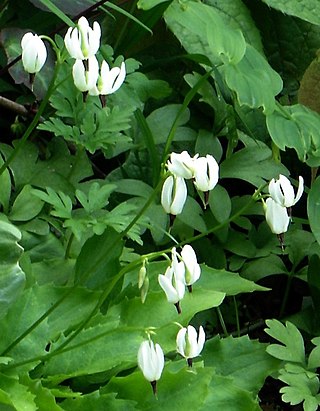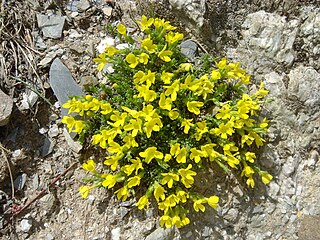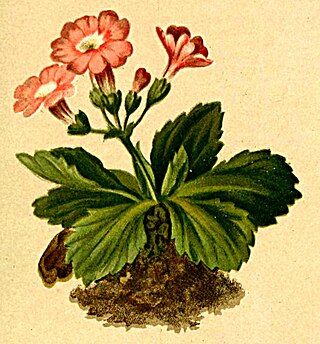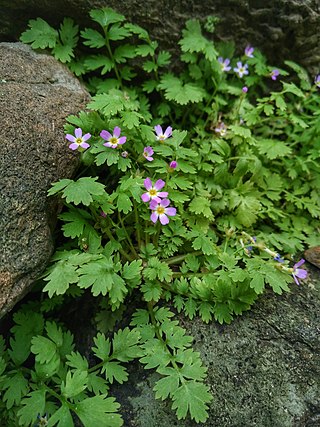
Leucospermum is a genus of evergreen upright, sometimes creeping shrubs that is assigned to the Proteaceae, with currently forty-eight known species.

Primula vulgaris, the common primrose, is a species of flowering plant in the family Primulaceae, native to Eurasia. The common name is primrose, or occasionally common primrose or English primrose to distinguish it from other Primula species referred to as primroses.

Primula auricula, often known as auricula, mountain cowslip or bear's ear, is a species of flowering plant in the family Primulaceae, that grows on basic rocks in the mountain ranges of central Europe, including the western Alps, Jura Mountains, the Vosges, the Black Forest and the Tatra Mountains.

Grevillea acanthifolia, commonly known as the Acanthus-leaved grevillea, is a plant in the family Proteaceae and is endemic to New South Wales. It is a shrub with stiff, prickly, divided leaves and pink to purple "toothbrush" flowers.

Cortusa is a formerly recognized genus in the family Primulaceae. It is now regarded as a synonym of the genus Primula. It consisted of about 19 species of delicate, hardy, alpine perennials. The genus was named by the herbalist Matthiolus after his friend Cortusus, professor of botany at Padua, who discovered the plant originally called Cortusa matthioli (now Primula matthioli. The plants are flowering herbaceous perennials native to the mountains of southern and eastern Europe, including the Alps and the Carpathians, with some species native to China. Most of the species are small spring bloomers for shade and rock garden. These low-growing and rather handsome little plants have clumps of downy, light green, heart-shaped leaves with serrated edges. In late spring, small loose umbel of delicate bell-shaped to lily-liked flowers born terminally on drooping spikes arise from the base, some 6-8in high. Flowers are magenta, pink, white and yellow. They are dormant in some months, and as spring begins, stems and leaves quickly start to reproduce.

Cyclamen coum, the eastern sowbread, is a species of flowering plant in the family Primulaceae. It is a tuberous herbaceous perennial, growing to 5–8 cm (2–3 in), with rounded heart-shaped leaves and pink shell-shaped flowers with darker coloration at the base. It is valued in horticulture as groundcover, and for the flowers which bloom in winter and early spring.

Leucospermum conocarpodendron is the largest species of the genus Leucospermum, reaching almost tree-like proportions of 5–6 m (16–20 ft) high with a firm trunk that is covered in a thick layer of cork that protects it from most fires. It has greyish or green narrow or broad inverted egg-shaped leaves with three to ten teeth near the tip and large yellow flowerheads, with firm, bent, yellow styles that stick far beyond the rest of the flower and give the impression of a pincushion. It is commonly known as the tree pincushion in English or goudsboom in Afrikaans. They naturally occur near Cape Town, South Africa.

Primula latiloba, synonyms Dodecatheon dentatum and Dodecatheon latilobum, is a species of flowering plant in the family Primulaceae, known by the common names white shooting star and toothed American cowslip.

Androsace vitaliana is a species of plant in the primrose family, Primulaceae. It was previously known by the synonym Vitaliana primuliflora. Native to the high mountains of Europe, it is cultivated as an alpine garden plant, being considered easy to grow in well drained soil in a sunny position.

Primula amethystina is a species of flowering plant in the family Primulaceae, native to China. The plant is commonly found in west and northwest Yunnan and southwest Sichuan, and across the border in Tibet. It typically grows best in wet, boggy soil.

Primula scandinavica is a species of flowering plant in the family Primulaceae.

Primula daonensis is a species of Primula within the family Primulaceae.
Primula heucherifolia is a species of flowering plant in the family Primulaceae.
Primula filipes is a species of flowering plant within the genus Primula and family Primulaceae.

Primula glutinosa, also known as the sticky primrose, is a species of flowering plant within the family Primulaceae.

Primula cicutariifolia, is a species of flowering plant within the genus Primula and family Primulaceae.

Primula borealis, also known as the Northern primrose or slender primrose, is a species of flowering plant within the genus Primula and family Primulaceae. The species is a halophyte, inhabiting coastal saline habitats within subalpine and subarctic regions.

Primula clarkei is a species of flowering plant within the genus Primula and family Primulaceae. The species is endemic to the Western Himalayas, where it can be found in Poshiana of the Pir Panjal mountain range.

Primula wollastonii, also known as Wollaston's primrose, is a species of flowering plant within the genus Primula and family Primulaceae. The species was first discovered and collected by A. F. Wollaston during an expedition to Mount Everest in 1921. The plant would later be scientifically described by Scottish botanist Isaac Bayley Balfour, who named the species P.Wollastonii after a request from Wollaston who had first discovered it.
Cyclamen somalense, also known as the Somalian cyclamen, is a species of flowering plant within the genus Cyclamen and family Primulaceae. It is endemic to Somalia, where it is significantly isolated from other Cyclamen species. The species tolerates higher temperatures than most Cyclamen species, being substantially closer to the equator than any other species within the genus.


















